 Pin it
Pin it
Gochujang Carbonara represents a brilliant culinary marriage between Italian comfort food tradition and bold Korean flavors. This innovative fusion dish transforms the beloved classic carbonara by incorporating gochujang, a fermented Korean chili paste that adds complex heat, subtle sweetness, and remarkable depth. The silky, creamy sauce still maintains its luxurious texture from eggs and cheese, but now carries an intriguing umami undertone with a gentle warmth that builds with each twirl of pasta. Unlike traditional carbonara, this version delivers a multidimensional flavor experience that keeps your palate engaged throughout the meal, creating something entirely new while respecting the soul of the original dish.
I first created this dish during a particularly cold winter evening when I was craving both the comfort of carbonara and something with a bit more heat. After spotting the container of gochujang in my refrigerator that I typically used for bibimbap, inspiration struck. The first attempt was revelatory, with the fermented chili paste integrating perfectly into the silky egg sauce. My skeptical Italian friend who initially raised an eyebrow at the concept became an immediate convert after her first bite, claiming it maintained the spirit of carbonara while creating an entirely new experience. This has since become my signature dish when hosting dinner parties, consistently surprising and delighting guests.
Essential Ingredients
- Large eggs: Form the foundation of the creamy sauce, providing richness and silky texture without the need for heavy cream.
- Egg yolk: Adds extra richness and depth to the sauce while helping emulsify the ingredients into a velvety consistency.
- Pecorino Romano cheese: Contributes essential saltiness and umami notes with its distinctive sharp, tangy flavor.
- Gochujang paste: Provides complex spiciness, subtle sweetness from fermented rice, and umami depth.
- Garlic powder: Offers consistent garlic flavor throughout the sauce without burning.
- Black pepper: Provides essential warmth and subtle spice that complements the more complex heat from the gochujang.
- Pasta: Bucatini, fettuccine, or rigatoni all work well to capture and cling to the sauce.
- Bacon: Provides essential fatty richness, saltiness, and satisfying chew.
- Scallions: Add bright, fresh notes and subtle onion flavor.
- Sesame seeds: Contribute subtle nuttiness, delicate crunch, and visual interest.
Preparation Method
- Sauce Creation:
- Whisk eggs and egg yolk in a bowl. Gradually add pecorino romano cheese while whisking. Incorporate gochujang paste until smooth, then season with garlic powder and black pepper.
- Pasta Preparation:
- Boil pasta in salted water until al dente. Reserve half a cup of pasta water before draining.
- Bacon Cooking:
- Cut bacon into small pieces and cook in a skillet over medium heat until crispy.
- Timing Management:
- Drain pasta and immediately toss it with rendered bacon and fat in the skillet, removing from heat.
- Sauce Integration:
- Pour the egg mixture over hot pasta, tossing continuously to create a smooth, creamy sauce.
- Consistency Adjustment:
- Add reserved pasta water gradually if needed for a silky consistency.
- Final Plating:
- Garnish with scallions, toasted sesame seeds, and fresh lemon zest.
 Pin it
Pin it
I learned the importance of timing with this dish after an early attempt where I added the egg mixture to a pan that was too hot, resulting in carbonara scrambled eggs rather than the silky sauce I was aiming for. My family now judges my carbonara skills by the smoothness of the sauce, and I've found that confidence and speed make all the difference.
Perfect Pairings
Pair this spicy, rich pasta with an arugula salad dressed with lemon juice and olive oil. A crisp Pinot Grigio balances the creamy sauce, while Korean makgeolli enhances the gochujang’s fermented complexity.
 Pin it
Pin it
Creating this gochujang carbonara brings me particular satisfaction because it represents how traditional recipes can evolve respectfully while creating something entirely new. The first time my Korean friend and Italian colleague shared a meal at my table, this pasta created an unexpected moment of culinary connection. Thoughtful fusion can create dishes greater than the sum of their parts.
Frequently Asked Questions
- → What exactly is gochujang and where can I find it?
- Gochujang is a fermented Korean chili paste that offers a perfect balance of sweet, savory, and spicy flavors. It has a thick consistency similar to tomato paste. You can find it in most supermarkets in the international or Asian foods section, in Asian grocery stores, or online. It typically comes in red plastic tubs or squeeze bottles and keeps well in the refrigerator for months.
- → Can I make this carbonara without bacon?
- Absolutely! For a vegetarian version, you can substitute the bacon with sautéed mushrooms, which provide a nice umami flavor. For a non-vegetarian alternative, pancetta or guanciale (traditional Italian cured pork) work beautifully. You could also use turkey bacon for a lighter option, though you might need to add a tablespoon of olive oil to compensate for less rendered fat.
- → How do I prevent the eggs from scrambling in carbonara?
- The key is to remove the pot from heat before adding the egg mixture. Make sure your eggs are at room temperature, and continuously toss the pasta while adding the egg mixture. The residual heat from the pasta will gently cook the eggs into a silky sauce without scrambling them. If you're nervous, you can temper the eggs by whisking in a few tablespoons of the hot pasta water before adding to the pasta.
- → Can I adjust the spice level of Gochujang Carbonara?
- Definitely! The recipe calls for 2-3 tablespoons of gochujang, which gives you control over the heat level. Start with 1 tablespoon if you're sensitive to spice or serving kids. For spice lovers, you can go up to 4 tablespoons. Remember that the cheese and pasta mellow out the heat considerably, so it often needs more than you might think.
- → What sides pair well with Gochujang Carbonara?
- This rich pasta pairs beautifully with something light and crisp. Try a simple green salad with a lemon vinaigrette, steamed or roasted broccoli, or even kimchi for doubling down on the Korean influence. Garlic bread is always a hit with pasta, or for a fusion approach, try garlic bread with a sprinkle of furikake seasoning on top.
- → Can I prepare any components of this dish ahead of time?
- While carbonara is best served immediately, you can prep some components ahead. Cook and chop the bacon in advance and store in the refrigerator. You can also mix the egg, cheese, and gochujang sauce earlier in the day and refrigerate. Just bring it to room temperature before using, as cold eggs are more likely to curdle. The final combining of pasta and sauce should always be done just before serving.
